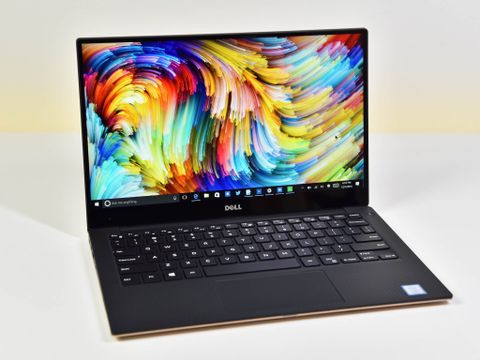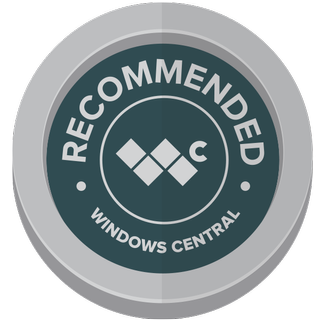
Dell's popular XPS 13 has had a mid-stream refresh for late 2016. The laptop was previously my top recommendation, and while it still sits near the top, it has a big problem: the competition is rapidly catching up.
Nonetheless, the XPS 13 (9360) is still an excellent machine. Its predecessor set a high bar, and while this is mostly a spec bump, there's still a lot to take in with the new Dell XPS 13.
Update 11/22/17: This review has been updated with benchmarks and a video review of the new 8th Generation Intel i7-8550U model for late 2017 from Dell.
Packed to the brim
Dell XPS 13 specifications
| Category | Dell XPS 13 9360 |
|---|---|
| Processor | Intel Core i3 or i5, 7th-generation Intel Core i7 8th Generation (NEW) |
| Internal Storage | Up to 512GB SSD |
| RAM | 4GB, 8GB or 16GB LPDDR3 2,133 MHz |
| Display | 1080p matte non-touch QHD+ glossy full touch |
| Graphics | Intel HD 620 |
| Ports | USB 3.1, 3.5mm jack, SD Card, USB-C Thunderbolt 3.1 |
| Wireless | Killer 1535 Bluetooth 4.1 802.11ac (Miracast enabled) |
| Battery | 60WHr |
| Weight | 2.8lbs (1.27 kg) |
| Dimensions | 11.98 x 7.88 x 0.33-0.60 in 304.29 x 200.15 x 8.38-15.24 mm |
| Colors | Silver, Rose Gold |
One thing that Dell is doing right is offering the XPS 13 with nearly every configuration possible. From Core i3 up to a Core i7; 4, 8, or even 16GB of RAM, and even different display types (non-touch matte full HD or touch-enabled glossy QHD). Storage ranges from 128GB to 512GB and is user-replaceable.
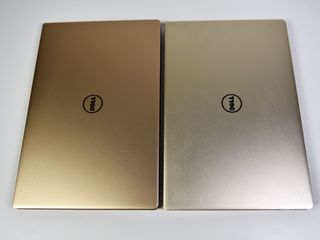
That means the starting price hits as cheap at $799, but a top-end configuration can go all the way past $1800. Even though the $799 machine only has a Core i3, 128GB of storage, and 4GB of RAM you still get that excellent XPS 13 design and look. You can't beat that for the price.
What's new: more battery, newer CPU, and better Wi-Fi
Dell has not rewritten the rulebook on the XPS 13 9360, which is a good thing and bad thing. Here are the significant changes from the previous 9350 model:
- 8th Generation Intel Core i7 quad-core processor (Late 2017)
- Battery increased from 56 to 60 WHrs
- Killer 1535 Wireless
- New 'Rose Gold' color scheme for all configurations
While those are not massive changes, they are all beneficial.
The new Kaby Lake processors run slightly cooler, get better battery life and even see a modest increase in performance mostly due to the improved Intel HD 620 graphics.
Getting a little larger battery is always welcome, and the Killer Wireless card for Wi-Fi does have exceptional range. In fact, while we were shooting this review video I could use the XPS 13 in a part of our office building where every other laptop frequently drops the signal. Not only did the Killer Wireless system stay connected, but I could hit 20MBps down when 60 feet way from the router separated by a hallway and two rooms. That was very impressive. Nonetheless, if you are always around a good signal, you won't see any improvements day to day with the Killer setup.
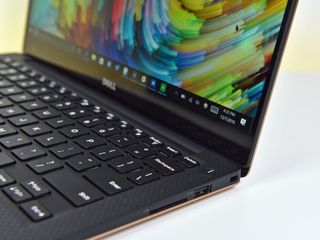
On another plus, Dell does not include the Killer Suite, which runs in the background and, to be frank, is mostly unnecessary. You can download it if you want, but I'm glad Dell left it off.
Even the Rose Gold – a shift from the previous 'just' Gold version – is welcomed. Rose Gold is like a light copper, and it's not nearly as flashy as before. It looks handsome and is just eye-catching enough. I should mention that Rose Gold, as opposed to the default silver, is an extra $50. At least this time, Dell is not limiting the option to the highest SKU with Core i7 and Iris graphics. Instead, you can get it in that color in any configuration.
So far, so good. I have zero complaints about these improvements, because, well, they are improvements.
Still the same, but still the best
Dell XPS 13 design
I won't go too much into the design of the XPS 13, as it hasn't changed in a few years now. Due to its near-bezel-free display, the XPS 13 still has the smallest footprint of any 13-inch laptop on the market. It's so tiny that it still seems weird – in a good way – when opening it.
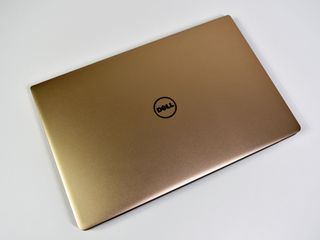
With an all-metal exterior and soft-touch paint and carbon fiber interior, the XPS 13 stands in contrast to the all-metal and chilly HP Spectre x360 and Apple MacBook Pro. One chassis style is not inherently better or worse than the other — it's a matter of personal preference. The soft-touch paint, while prone to oil, really feels luxurious and inviting. It's a classy looking machine.
For ports, you still get a Thunderbolt 3 USB Type C and two USB Type A along with a dedicated SD card slot, LED battery checker, headphone jack, and Kensington lock. Dell still including an SD card reader is one reason for some to consider this laptop over others if frequently used.
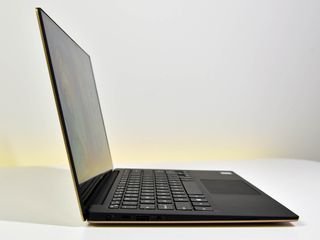
While you still can't open the XPS 13 with one hand thanks to its stiff hinge, that also means the screen has very little wiggle and bounce to it. Those that get the touch option will appreciate the stiffness.
Overall, I rate the build quality and fit and feel of the XPS 13 as very high. It's expensive, but at least it looks and feels the part.
Quad HD brilliance
Dell XPS 13 display
There are two display options as always from Dell. There is the Full HD (1920x 1080) matte, non-touch option, which and the $300-more-expensive and absolutely gorgeous QHD (3200x1800) glossy, touch version.
Which is better? It depends on your needs. I think the matte FHD version is an outstanding panel for those who read and type a lot and value battery life. That version should be able to squeak out an extra two to three hours of usage. And being matte, you get virtually no glare, making it easier on the eyes. That's huge if you read or write a lot. It's also $300 cheaper, which is not insignificant, and if you don't ever use touch (myself included) not a step-down.
But oh, that QHD version!
I do advise if you are trying to choose between the two display types and are leaning towards the Full HD that you just not go and see the QHD one. It's almost too good. The IGZO display is super bright, high contrast, and just jaw dropping. Does it make me write better articles? Comprehend data any faster? Improve my productivity? Not at all, but it is mesmerizing.
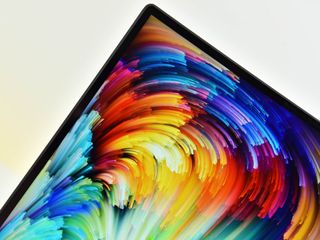
I can say without reservation that the XPS 13 (9360) still sets the bar for displays. If you do photography, image work, etc. and need something small and compact, this is still your machine.
Great, but not the best
Dell XPS 13 keyboard
Dell's keyboards are not as universally loved as those on the Surface or other laptops. Some find the 1.3mm of key travel a little "mushy." The keys are also plastic and prone to showing oil after use. Personally, I'm fine with them and can type well enough without any learning curve. The keys are a bit small compared to other similar laptops, but not so much that I would pass on the device.

The XPS 13 features a two-stage backlighting system that contrasts nicely with the black keys. There is a slight light bleed or halo-effect around each key, and I'm not sure if that is by design or not.
Overall, the XPS 13's keyboard is above average, but not groundbreaking. The spacebar can still be a little odd at times too, and some users have reported issues with it sticking in older models.
Precision is critical
Dell XPS 13 trackpad
The XPS 13 continues to utilize Microsoft's Precision technology. That means native Windows 10 gesture support and that it will get new gestures with the forthcoming Creator's Update due early next year. I'm a huge Precision snob, so the XPS 13 feels perfect for me to use, and those gestures work consistently with no delay.
The hardware, though, is not quite as good as the HP Spectre x360's, which is smoother and more glossy (not to mention larger). The click is good, but make sure that your trackpad is not loose if you pick one up (some rattle annoyingly when tapped, which is not how it ought be).

I have no major issues with the XPS 13's trackpad, but I have seen others complain about it more than I would expect. That may come down to a combination of personal preference (people don't like the soft-touch paint feel) and production issues (the rattle). While I think Dell could improve some of the hardware, I still find it above average, and the Precision part keeps it ahead.
More fasterer!
Dell XPS 13 performance
The XPS 13 (9360) unit I'm testing features a dual-core 7th-generation Intel Core i7 "Kaby Lake" CPU that clocks up to 3.5Ghz with 8GB of LPDDR3 1866MHz RAM and a 256GB PCIe SSD. Like most Windows Ultrabooks, this is a 15W chip and not a more powerful 28W found in laptops like the VAIO Flip Z or 2016 MacBook Pro.
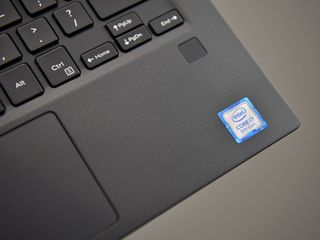
It's a fast machine and holds up well on Geekbench 4 with a Single core score of 4120 and a dual-core score of 7829. Both numbers are notably higher than the previous Skylake Core i7 variant (9350).
CPU
Geekbench 4.0 benchmarks (higher is better)
| Device | CPU | Single core | Multi core |
|---|---|---|---|
| Dell XPS 13 (9360) | i7-8550U | 4,690 | 14,334 |
| Dell XPS 13 (9360) | i7-6560U | 4,120 | 7,829 |
| Surface Book 2 13 | i7-8650U | 4,862 | 14,694 |
| Surface Laptop | i5-7200U | 3,725 | 7,523 |
| HP EliteBook x360 G2 | i7-7600U | 4,496 | 8,435 |
| Samsung Notebook 9 15 Ext | i7-7500U | 4,316 | 8,320 |
| Lenovo X1 Carbon | i5-7300U | 4,139 | 8,311 |
| HP Spectre 13 | i7-7500U | 4,100 | 7,469 |
It's quite evident that the new i7-8550U processor gives a big boost to the mutli-core score due to the new quad-core design. Moreover, the single-core score gets a nice boost too. The new Microsoft Surface Book 2 13 edges out the XPS 13 slightly, but that's due to the higher-clocked chip found with the i7-8650U.
GPU
Geekbench 4.0 OpenCL (higher is better)
| Device | Compute score |
|---|---|
| Dell XPS 13 (NEW) | 22,555 |
| Surface Laptop | 19,256 |
| HP Spectre x360 15 | 28,868 |
| Samsung Notebook 9 15 Ext | 23,207 |
| HP EliteBook x360 G2 | 21,512 |
| Lenovo X1 Carbon | 20,932 |
| Dell XPS 13 (OLD) | 19,410 |
| Surface Book HD520 | 18,197 |
| Dell Latitude 7280 | 17,827 |
Although this is still the same HD 620 graphics for the updated XPS 13 we can see even the OpenCL score gets a slight overall boost compared to last year's model.
PCMark
PCMark (Home Conventional 3.0)
| Device | Score |
|---|---|
| Dell XPS 13 i7 | 3,280 |
| Surface Book 2 13 | 3,341 |
| Surface Laptop Core i5 | 2,494 |
| Samsung Notebook 9 15 Ext | 2,998 |
| Lenovo X1 Carbon Core i5 | 2,965 |
| HP EliteBook x360 G2 | 2,916 |
| Dell Latitude 7280 | 2,829 |
| HP Spectre x360 15 | 2,472 |
Again, we can see how the new 8th generation Core i7 processors significantly outpace last year's models. Both the Surface Book 2 13 and XPS 13 make large strides in PCMark 8.
SSD
CrystalDiskMark (higher is better)
| Device | Read | Write |
|---|---|---|
| Dell XPS 13 (NEW) | 1,368 MB/s | 847 MB/s |
| Dell XPS 13 (OLD) | 1,287 MB/s | 794 MB/s |
| Surface Book 2 13 | 1,411 MB/s | 1,202 MB/s |
| Surface Laptop | 423 MB/s | 237 MB/s |
| Lenovo X1 Carbon | 1,518 MB/s | 1,188 MB/s |
| Samsung Notebook 9 Ext | 1,365 MB/s | 1,213 MB/s |
| HP EliteBook x360 G2 | 1,129 MB/s | 916 MB/s |
| HP Spectre x360 15 | 1,128 MB/s | 862 MB/s |
Dell is still using well-sourced Samsung SSD's in many of the 512GB and 1TB options for the XPS 13 resulting in above average storage performance.
Updated 11/22/17 with new 8th generation processor scores for the XPS 13 with Core i7
Overall, the XPS 13, especially with the new 8th generation Core i7-8550U procesor, is an excellent performer.
Thermal excellence
Dell XPS 13 heat and fan noise
The XPS 13 (9360) does very well for heat and fan noise compared to other Windows 10 laptops. The fan is exceptionally silent under normal usage and rarely is noticeable in modestly quiet rooms.
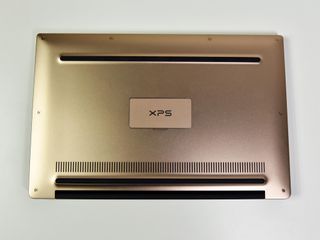
While the XPS 13 puts out about the same temperatures as the Spectre x360 under heavy load (peaking at around 115F), the dissipation is not nearly as noticeable due to Dell's better thermals. In fact, I struggle to find it getting warm under regular daily usage.
Hours on end
Dell XPS 13 battery life
Between Dell's usage of the new, more efficient 8th Generation Intel processor and adding an extra 4WHrs to the battery (for a total of 60) the new XPS 13 (9360) has better battery life than ever.
The decked-out Core i7 model with QHD touch display easily gets over 10 hours of real-world usage. It slightly edges out the Spectre x360 here by about 90 minutes. If you drop from the QHD display to the less power-hungry non-touch Full HD version, I could easily see this laptop pushing 13 hours.

Charging is still the same, with Dell's barrel charger setup (instead of a Type-C fast charge). While I would have preferred just Type-C (it's the future!), the Dell charger is just a teeny thing and is entirely fine for tossing in a bag without batting an eye.
Overall, if battery life is important, the XPS 13 (9360) should be on the top of your list for consideration.
The best got better, but so did everybody else
Dell XPS 13: The bottom line
So far, the Dell XPS 13 (9360) seems to get almost everything right. Plenty of configuration options, updated and performant hardware, outstanding battery life, all in a device that looks fantastic.
The problem is not with the XPS 13 per se but the fact that HP (Spectre x360) and Lenovo (Yoga 910) are innovating around them at a lower cost. While they're all three great laptops, the XPS 13 misses out on both Windows Hello security authentication (fingerprint or facial recognition) and even though it offers a touch screen it is still stuck in a traditional non-convertible form factor.

While I'm not a huge convertible or touch display user, you can use those devices today without any compromise. In other words, it's nice to have, even if it's not a priority usage scenario. The lack of Windows Hello is aggravating if only because I think consumers should expect such functionality in premium hardware – which the XPS 13 most certainly otherwise is.
There is also the still awkward web camera placement below the display, which almost always results in a less-than-flattering angle for video chats. While no one is sure how Dell should solve it while keeping the Infinity Edge display, something may have to be done.
Finally, there is the price. Dell smartly starts the XPS 13 off at $799 and that is a deal for a premium "budget" machine that looks super high-end. But the version I tested here (Core i7, 8GB, 256GB, Rose Gold) goes for $1649. That's $350 more than what HP charges for a Spectre x360 equipped with a Core i7 processor, 16GB of RAM, and 512GB of storage. Plus, that device is a convertible, has Windows Hello, and is arguably better built. You don't need me to tell you which is the better value for your dollar.
And that is where the XPS 13 sits in late 2016. It's still in every way a fantastic laptop that I still delight in using. Everyone who sees that QHD Infinity Edge displays nearly gasps. It's fun to use, it's reliable, and Dell has been delivering frequent driver and BIOS updates to keep it running smoothly.
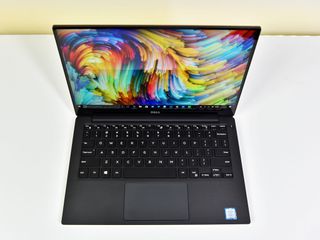
Despite all of that, for the price and feature set the XPS 13 is starting to get a bit stale. I worry that Dell is getting a little lax with its XPS 13 – which is arguably the top selling laptop in this range – and they are not innovating enough. While I do not think a dramatic redesign is in need things like Windows Hello and an improved keyboard and trackpad should be on the table already.
If you need a small, powerful 13-inch laptop with an outstanding high-quality display, I can still recommend the XPS 13. It's just now I would also tell you to take a serious look at what HP and Lenovo are doing. So, come on Dell, you can still do better.
Pros:
- Still excellent design.
- Strong performance.
- Outstanding QHD display.
- More configuration choices.
- Class leading battery life.
Cons:
- Expensive.
- No Windows Hello.
- Prone to oil and dirt.
- Still awkward web cam.

Daniel Rubino is the Editor-in-chief of Windows Central. He is also the head reviewer, podcast co-host, and analyst. He has been covering Microsoft since 2007, when this site was called WMExperts (and later Windows Phone Central). His interests include Windows, laptops, next-gen computing, and watches. He has been reviewing laptops since 2015 and is particularly fond of 2-in-1 convertibles, ARM processors, new form factors, and thin-and-light PCs. Before all this tech stuff, he worked on a Ph.D. in linguistics, watched people sleep (for medical purposes!), and ran the projectors at movie theaters because it was fun.
